The BitFenix Whisper M 450W & 850W PSU Review
by E. Fylladitakis on February 15, 2017 9:00 AM EST- Posted in
- Cases/Cooling/PSUs
- PSUs
- 80Plus Gold
- bitfenix
- Modular
External Appearance
Physically, the 450W version of the Whisper M is almost entirely identical to the 850W version. The only real way to tell the two units apart is to look at the large stickers with their electrical specification at the top of the chassis or know the cable layout variations in the series. Both units are built in a standard-size ATX chassis that is 160 mm long and sprayed with a matte black paint. The matte paint is very well applied but it is easy to scratch and heavily prone to fingermarks.
A square opening at the bottom of the chassis reveals the cooling fan and is covered with a finger guard that uses a parallel grating. The only round part of the metallic design is the company’s badge over the fan’s engine. Black/Yellow stickers decorate both sides of the PSUs, without any mention of any figures or model numbers. Only the large stickers at the top of the chassis has the full electrical specifications of the PSU printed on it.
The front side of the PSU is littered with the connectors for the many modular cables. Here the 850W version has two connectors more, for the two additional PCI Express cables that it has.
Internal Design
As expected, considering the large difference in power that the two PSUs have, their first major difference is the 135 mm cooling fan. Both fans are supplied by Martech, a rarely-seen Chinese manufacturer, and both are of the same series. The 450W version comes with the DF1352512SEMN and the 850W version employs the DF1352512SEHN, with the main difference being their maximum rotational speed - 1500 RPM and 1800 RPM respectively. Both are using “Hydro” bearing engines, which are advanced forms of regular sleeve bearings.
The OEM behind the Whisper M units is Channel-Well Technology (CWT), a company that we are very familiar with. However, this is a design that we have never encountered prior to this date. First and foremost, it is worthwhile to mention that both PSUs are based on the same platform, meaning that all of the different versions of Whisper M should all be on this platform (it would be rare for a mid-powered unit to differ). A quick glance reveals that there are no great differences between the two PSUs other that the sizing of some of the components. We were actually bewildered to see that the 850W version is using the same heatsinks as the 450W version does, despite having nearly twice the power output, hinting that the employment of the more powerful fan was more of a necessity and less of a precaution.
The internal design of the Whisper M units is very clean, with minimal use of wires at all. The secondary board with the modular cable connectors is soldered directly onto the main board, hinting that CWT has designed this particular platform for modular-only PSUs. We can see that both units are sharing the same filtering stage, with four Y capacitors, two X capacitors, and two filtering inductors. The heatsink of the input conversion bridge is identical, but the bridge itself is (vastly) different between the two units. Specifically, the 450W version employs a GBU606 that is capable of 6 Amperes, whereas the 850W version is making use of an oversized GBU15L06, a bridge capable of 15 Amperes.
BitFenix Whisper M 450W - Internal View
Another major component difference between the two units are the PFC components, with the 450W unit using a Nichicon 330μF capacitor, whereas the 850W version has a Nippon Chemi-Con 680μF capacitor installed. The APFC inductor is also notably larger and the active components are significantly more powerful. Two transistors form a relatively simple half-bridge primary inversion side with its efficiency boosted by an LLC resonant converter. The four secondary side conversion stage transistors that generate the 12V output are attached to the underside of the main PCB and cooled by the silvery heatsinks next to the main transformer. The 3.3V and 5V outputs are generated by DC-to-DC circuits found on the small vertical PCB.
BitFenix Whisper M 850W - Internal View
It is worthwhile to notice that both units are using filtering capacitors of the same type and size at the secondary side for filtering. Nippon Chemi-Con supplies the electrolytics and most solid-state capacitors, with the rest of the solid-state capacitors coming from Nichicon.


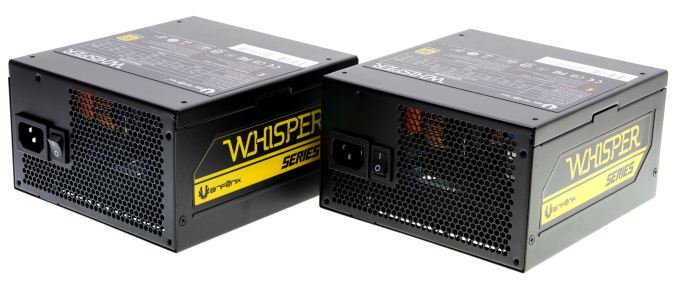
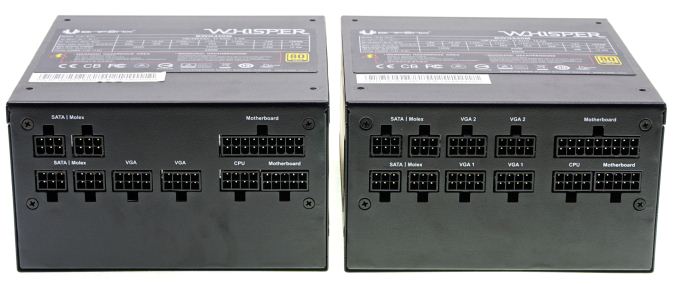
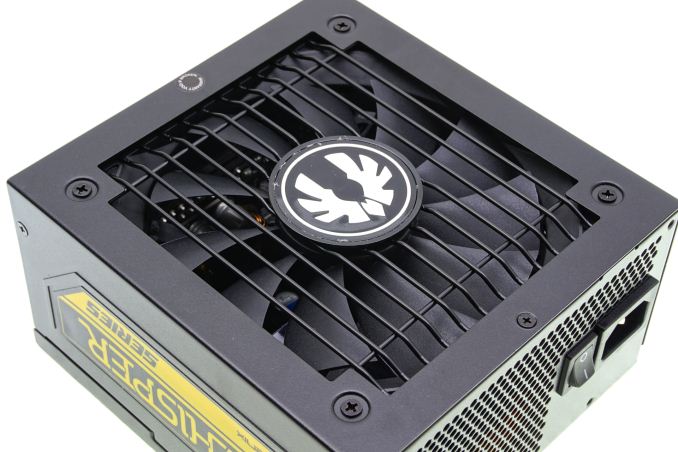
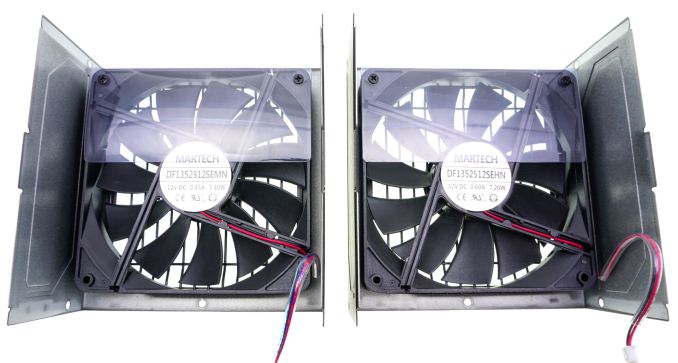
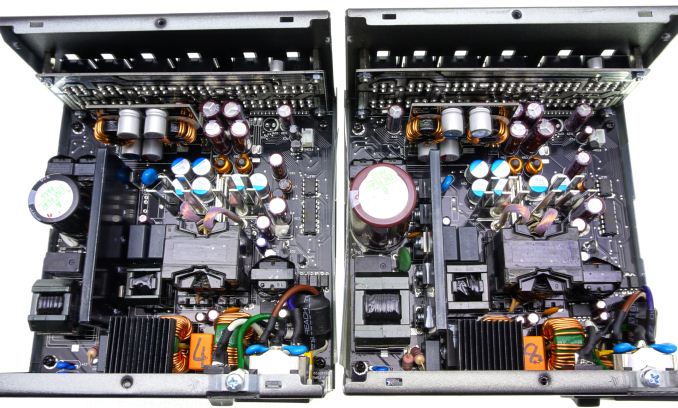

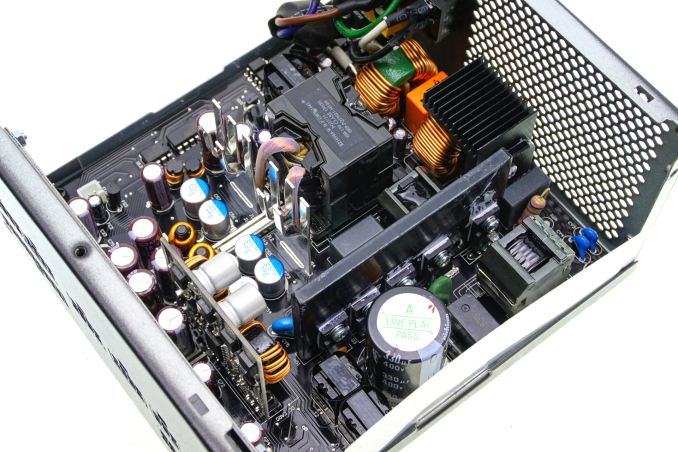

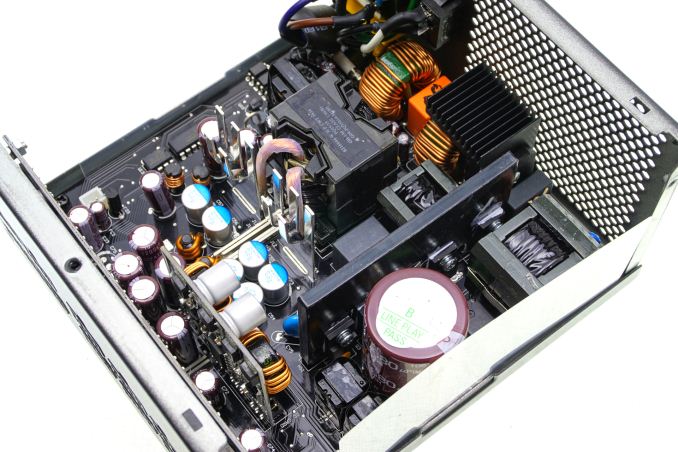








15 Comments
View All Comments
Chaitanya - Wednesday, February 15, 2017 - link
Those cables certainly look nice, especially the 24pin cable.HomeworldFound - Wednesday, February 15, 2017 - link
The 24pin cable looks pretty good. The 24pin ATX cable has really gotten annoying for me. Is there no way to further innovate in that area?The_Assimilator - Thursday, February 16, 2017 - link
Barring another revision of the ATX spec, the best we can hope for is right-angled 24-pin connectors on motherboards a la EVGA.DanNeely - Thursday, February 16, 2017 - link
As stagnant as the desktop's become about the best we could hope for is to declare about 1/3rd to 1/2 of the pins in the big connector optional (-12v, most of the 3.3/5v, and a few of the corresponding grounds) and have a big sparsely wired connector.I'm not sure a right angle 24pin socket is actually a good idea in general. Cable routing is far worse with it in a compact case without wiring space behind the mobo. Even if you have wiring space behind the mobo, it's still a much more cramped space to be trying to make the tight bend you need to get it into position. It also makes having a cable hole mis-aligned with where the mobo connector is a lot more problematic; with a vertical socket you can just feed an extra few inches up to shift to the side, horizontally not so much. Lastly I'd be a bit leary about it just in terms of general strain relief. The great big fat cable can pull on the socket really hard if it's alignment is off and a tall cable loop coming up gives a lot more potential slack to dissipate the force than a tight 180* turn coming through the cable hole.
BrokenCrayons - Wednesday, February 15, 2017 - link
It's easy to overlook a typo on the box to pick up a very reasonably priced PSU with high efficiency and good test results. The absurdly long warranty is a bonus. I think we've got a winner here.jardows2 - Thursday, February 16, 2017 - link
Maybe it's intentional, and should be read as Perf-Romance - as in you'll fall in love with the "perf" of this product!fire400 - Sunday, February 19, 2017 - link
lol.. great marketing strategyDrumsticks - Wednesday, February 15, 2017 - link
How does this compare to the RM550x, which made it onto your best of list last year?It looks like a pretty good unit, though, and for a little bit less than the 550x. Hopefully we can see more stock like you said. I can't find it in the US at all.
fanofanand - Wednesday, February 15, 2017 - link
These PSU reviews might not gather as many comments or as much appreciation, but the next time someone is putting together a new build they will appreciate the time and effort spent. BitFenix has been doing some really great things lately and it looks like this PSU will continue that trend. Nice job with this review.wolfemane - Wednesday, February 15, 2017 - link
I really wish this review had come out just a few days earlier. Wound up getting a RM550x for a bit more. BUMMER!